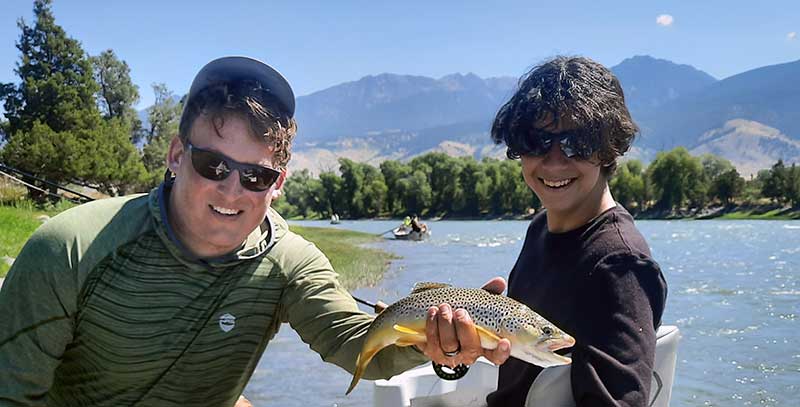Late Fall Float Trips
Posted on January 23rd, 2024
Late Fall Float Trips: Introduction
Late autumn begins when nights begin falling below freezing most nights rather than just occasionally and the first snow that doesn’t all melt by midafternoon starts to fall now and again. Most years, the first week of October is when this occurs.
After the switch flips there’s no reason to get out early in the morning save for hardcore anglers who want to try for one or two really big fish with streamers. The best fishing is typically from about 10:00AM through about 4:00PM. For this reason, almost all late fall trips operate as “shoulder season” 3/4-day trips, with 5–6 hours on the water.
Fishing is slow-paced at this time, with nymphs and streamers pounded in the deeper runs the most likely producers, but big numbers of rising trout also possible during good BWO hatches. This is the time of year when guides do most of their fishing. Little wonder. The big fish are eating, but there isn’t much work. Want to find out why the guides tend to like fishing during this period?
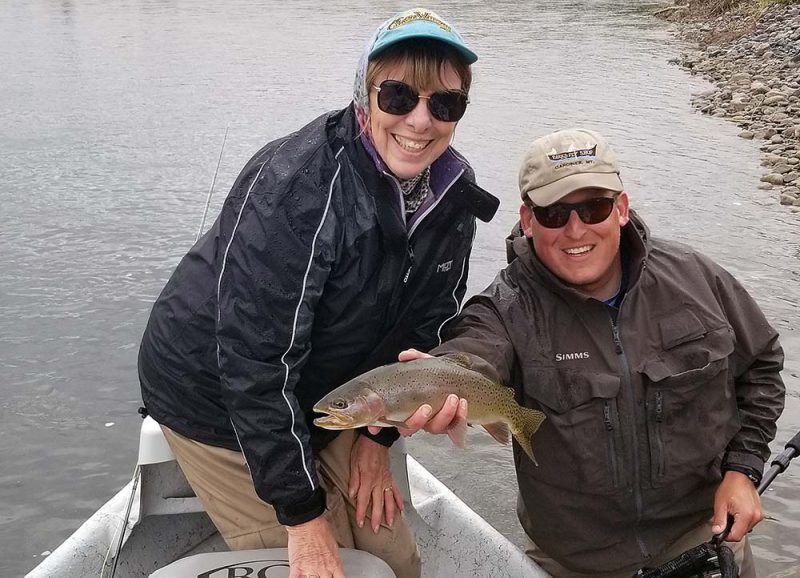
Late Fall Float Trips: Quick Facts
- Best Waters: All waters that remain high enough to float this late in the year can be excellent, but we generally stick close to home on the Yellowstone.
- Three Top Reasons to Come in Late Autumn: 1.) This is an excellent time to target big fish, 2.) Crowds are nonexistent, and 3.) the dry fly fishing can still be good for a couple hours each afternoon, and it’s generally much better than early spring.
- Three Top Reasons to Avoid Late Autumn: 1.) Weather and water conditions are wildly inconsistent and can be miserable: it can snow feet and remain below freezing for days at a time, or be too warm and bright. 2.) The numbers of fish caught on an average day are far lower than in summer, and 3.) Morning fishing is very slow most days.
- Perfect Clients: Experienced anglers who want to fish nymphs and streamers for larger fish, with a solid chance of some good dry fly fishing many afternoons.
- What Late Autumn Does Best: Produces big browns on their spawning runs and the rainbows that follow them looking for a meal of eggs.
Late Fall Float Trips: The Details
Things fall apart in late fall (October and early November), but they fall apart in a delightful way. With the possible exception early spring, this is the best big fish period of the season on float trips, and since the early autumn hatches continue to a degree, this is still an okay time for solid numbers of trout on dry flies as well.
The top rivers at this time are the Yellowstone, the lower Madison, the Missouri near Holter Dam, and the lower Gallatin, Jefferson, and the Missouri River headwaters (these last three waters only for those wanting one or two monster trout). We spend most of our personal and guiding time on the Yellowstone.
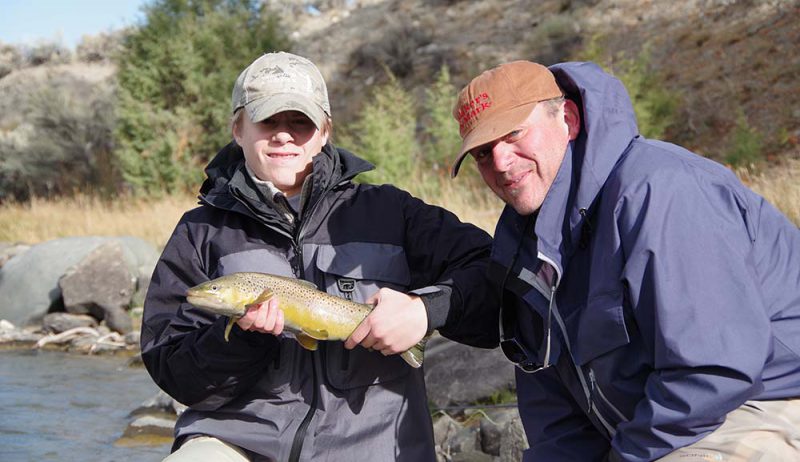
Most fishing during this period is subsurface, with streamers producing the largest fish and midge pupae, BWO nymphs, and egg imitations producing the numbers. BWO hatches continue and can produce good dry fly fishing for an hour or two in the afternoons and the fish willing to eat the nymphal forms of these bugs much of the rest of the time. The main driver of the fishing at this time isn’t bugs, however. It’s the upcoming or underway brown trout spawn.
In early October, the big browns are migrating to spawning areas and feeling aggressive, making streamers targeting these fish the best tactic.
In late October and early November, the browns are in the midst of their spawn. We do not target actively spawning wild trout on any of our trips, but the non-spawning rainbows, cutthroats, and even non-spawning or pre-spawn browns that hang below their cousins chomping eggs are fair game. Egg imitations are the best flies for these fish, but they’re frequently quite aggressive to a variety of flies, including dead-drifted streamers and mayfly nymphs as well as eggs.
Weather and water conditions can be rather… burly… at this point in the year. Early cold snaps in particular can make both the fishing and just being on the water a challenge. Ideal conditions see air temperatures between 45 and 55 degrees with cloud cover, drizzle, and occasional flurries. Let that sink in. Gross and uncomfortable weather produces the best fishing. The bright, sunny, warm, Indian summer sort of days most people love to see in October are poor for angling at this time. “Winter in October” is also bad, but it does require seriously ugly weather for us to consider canceling: temperatures below freezing, with wind and precipitation. Bear that in mind before booking a float for this period.
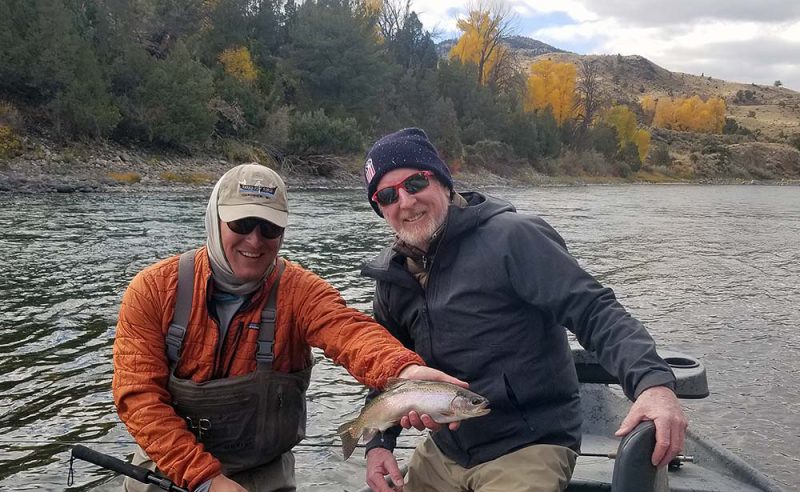
There’s almost never any reason to get out early during this period, particularly after the middle of October. We mostly run half-day trips meeting around 10:30AM.
Late fall floats are better for experienced anglers who know what they’re getting into in terms of the weather, but particularly early in this period they’re still good bets for beginners, and they’re not poor choices for rookies right up until it gets too cold to want to float for the rest of the year. This is because nymph tactics in slow-moving water are often the best tactic for numbers of trout, often with the boat stopped in likely areas. This give beginners plenty of second chances to get the casts and drifts right and will not overwhelm them.
This is a poor time for young kids, since they often get cold/wet/miserable given the “standard” fall weather.
Our float season concludes sometime in early November when it gets too cold to make these trips feasible.
>>>>>>>>>> Back to Float Trips Page
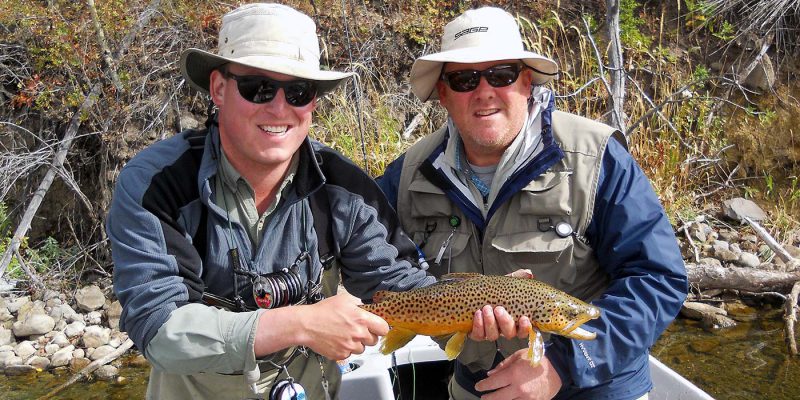
Early Fall Float Trips
Posted on January 23rd, 2024
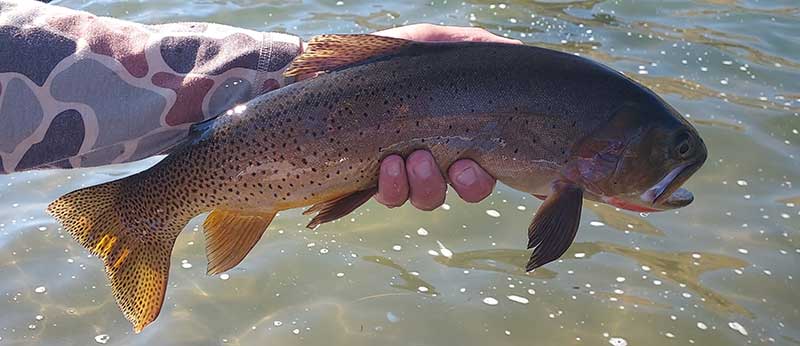
Early Fall Float Trips: Introduction
As air and water temperatures cool in late August or the first week of September, flows continue to drop and aquatic insect hatches turn back on. The next month or so, basically the month of September, offers the best match-the-hatch fishing of the season. Even large trout sometimes rise to tiny flies, and good fishing is still possible with terrestrial dry flies as well.
Early fall float trips are all about flexibility. If it’s warm and bright, we’ll want to fish hoppers and ants for numbers of free-rising cutthroats on the upper Yellowstone or for rainbows and browns on the lower Stillwater. If it’s cool and gray, it might be prime time to float the Yellowstone’s “town section” or east of Livingston and hope for a few monsters.
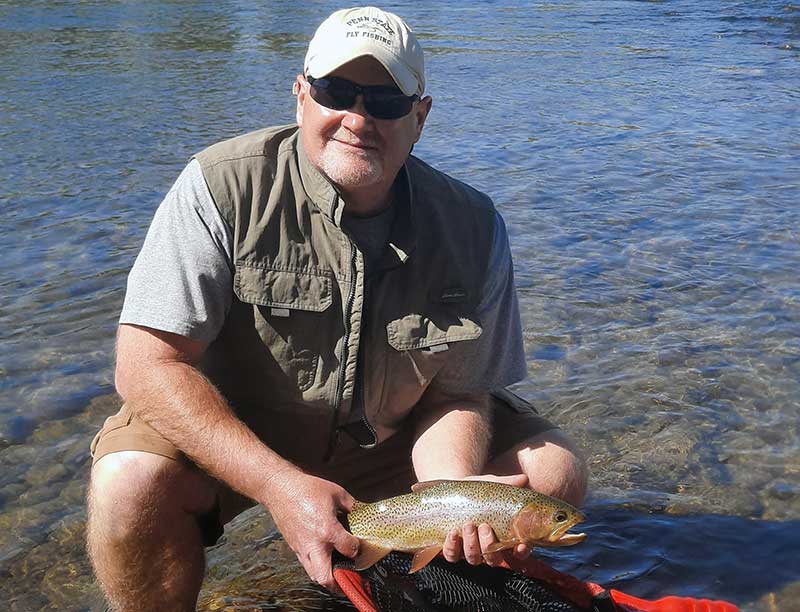
This is rapidly becoming the second most-popular period for float trips in the region, after early summer, and for good reason: the weather and water conditions are great, the fish are fat and healthy, and the crowds of general tourists have departed. There can still be quite a few fishing boats out on the water, but except on Labor Day Weekend there are far fewer than during the summer. The Stillwater River in particular is far less busy once September rolls around than earlier.
Here are a couple facts to keep in mind while you read this post:
- Early autumn is our favorite time to guide float trips on the Yellowstone and Stillwater Rivers (provided the Stillwater is high enough, sometimes it’s too low in the fall).
- While there aren’t any monster trout included on this page, every pictured fish here ate a dry fly. In fact, probably 80% of the trout we see on early fall float trips eat dries. Most of the rest eat emergers or small nymphs beneath these dries.
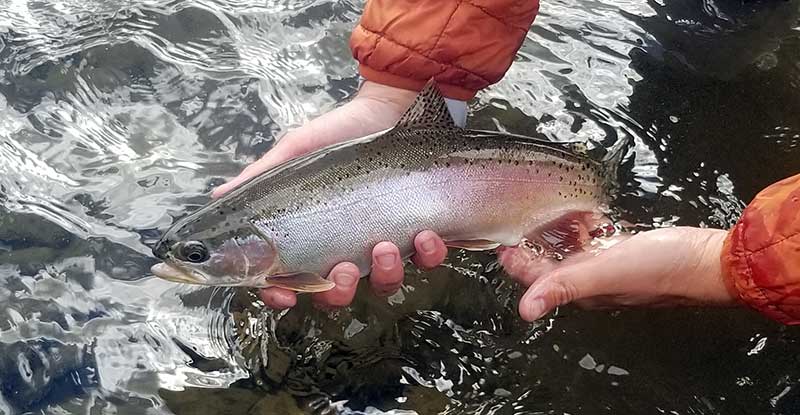
Early Fall Float Trips: Quick Facts
- Best Waters: The Yellowstone and Stillwater are the best options at this time, but the Lower Madison turns back on, as well.
- Three Top Reasons to Come in Early Autumn: 1.) The widest range of tactics of the season might work at this time, depending on weather and water conditions. 2.) Crowds of general tourists nosedive, and while there can still be quite a few anglers out on big-name rivers like the Yellowstone and Madison, there are far fewer than earlier in the year. Note that popular wade fisheries remain quite crowded through September. 3.) The best “match-the-hatch” fishing of the year typically occurs during this period.
- Three Top Reasons to Avoid Early Autumn: 1.) Fishing and weather/water conditions are less consistent than they are during the summer. 2.) The fish can be spooky. 3.) The fishing tends to “ebb and flow” much more at this time of year than earlier: it’s good for a while, then gets tough, or vice-versa.
- Perfect Clients: Clients who enjoy less-crowded conditions, come prepared for a wide range of weather and water conditions, and are willing to use the tactics the trout demand, whatever they may be. Early fall also offers some of the easiest beginner floating of the year, due to the aggressiveness of the mountain whitefish.
- What Early Autumn Does Best: Early fall offers great (if sometimes inconsistent) match-the-hatch fishing during Blue-winged Olive mayfly emergences. This is our favorite hatch of the year, which is why early fall is our favorite time to guide float trips.
Early Fall Float Trips: The Details
Early fall is just awesome. The fishing isn’t as consistent as it is in early summer, and the big grasshoppers don’t work as well as they do in late summer, but the mayfly hatches, the eagerly-rising trout that are in their best shape of the year, the falling crowds of competing anglers, and the fall colors more than make up for it.
This period runs from the first hints of colder weather in late August or early September when the late summer water temps drop sharply, until the first really cold weather hits sometime in early October. On warm days, this is still wet-wading season. On cool, rainy days, we wear waders and layer up and are very happy to do it.
With cold nights and often hot days, and a good chance of fall rains to freshen the rivers and make the mayflies hatch, the fishing is extremely varied at this time of year, both from day to day and even over the course of a given day. It’s often hard to predict what will happen, even with an accurate weather forecast. This makes early fall the most interesting time of year to fish the region, for good and ill.
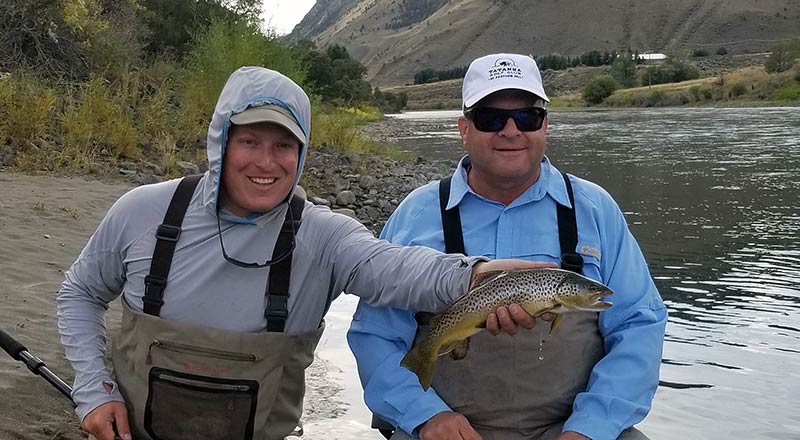
Tactics are all over the place in early fall, but we emphasize dry fly fishing on the Yellowstone River and dry-dropper on the Stillwater and Lower Madison. Streamers are a changeup technique for experienced anglers. We seldom resort to strike indicators and deep-nymphing in early fall except when guiding beginners.
First thing in the morning, we might throw streamers before switching to mayfly imitations, then swap the mayflies for grasshoppers during the warmest part of the day. Or the day might start off warm and sunny with hoppers hopping, then get cloudy and cool and prompt an immense afternoon mayfly hatch.
Regardless of the specific fly we tie on a client’s line, the prime mover of early fall fishing is mayfly emergences. Hoppers and ants still draw some action, but mayfly imitations both on the surface and fished as droppers under hoppers are what separate the great days from the decent ones.
There are several mayflies of note: Mahoganies, Tricos, Tan Drakes (sometimes called Drake Mackerals), and especially several species of Blue-winged Olives (BWO or Baetis). If the mayflies are hatching in profusion and the trout are going crazy, the fishing can be epic. If there’s at least a trickle of mayflies, the fishing will be solid. If it’s bright and sunny and the mayflies aren’t popping, it might be tough unless the hoppers are still hopping in profusion.
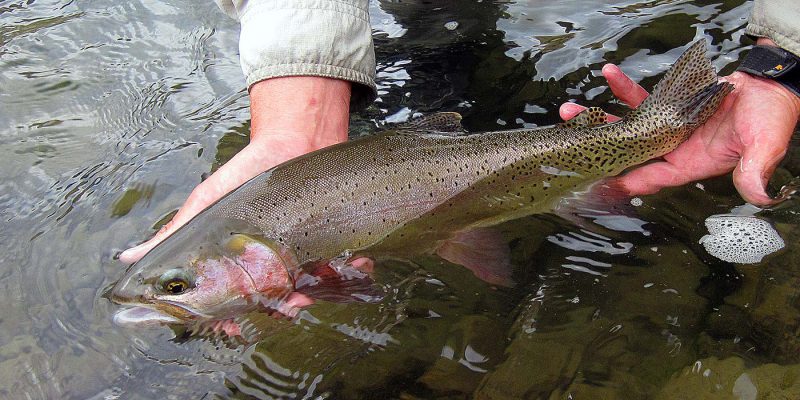
The epic dry fly days in our guiding year are more likely to happen at this time than at any other. This is also the period during the peak season when fishing is likely to be tough. We like to tell people that floating in July will usually mean a seven or eight out of ten in terms of angling quality. In early fall, it might well be a ten. It might also be a two. Sevens and eights are still more common, but the variability is higher in early autumn, and it’s important to accept that.
Variability is actually less common with beginners in early fall than with experienced anglers. Why? Whitefish. These under-appreciated gamefish are preparing for their spawn and therefore hyper-aggressive. This makes them great beginner options. We typically have beginners fish a nymph and a streamer under an indicator, and they’ll usually fill the boat with “whiteys” and get a few good trout, too. This opportunity makes early fall the best time for beginners to float.
Early fall is a good time for anglers who like to keep “banker’s hours.” Unless our clients want to throw streamers first thing in the morning for chances at one or two big fish, there’s seldom any reason to be on the water before 9:00 or 10:00. The fishing is usually good until around 5:00. We typically run either full-day trips that run a hair short or half-day trips that aim to get on the water around 10:30 or 11:00.
>>>>>>>>>>>>> Return to the Float Trips Page

Late Summer Float Trips
Posted on January 23rd, 2024
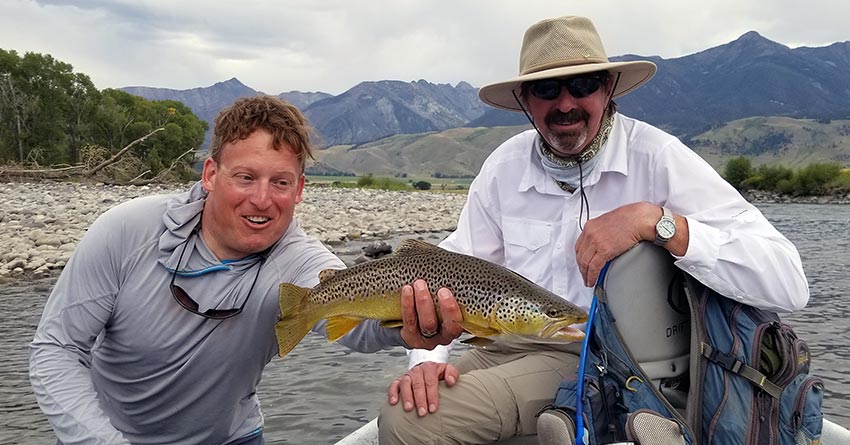
Late summer is a prime period for larger trout on dry flies. This one (like most) ate a grasshopper imitation in fast water.
Late Summer Float Trips: Introduction
Late summer begins when rivers drop from the edges of the bushes and get slower. In the meantime, rivers turn crystal clear rather than green and aquatic insect hatches diminish, but terrestrial insects such as grasshoppers and ants begin blowing into the water in greater and greater numbers.
Some rivers get too low and in some cases too warm, but others become less challenging to fish, particularly in terms of the accuracy of casts required. While not quite so consistent as early summer, this period often offers easier fishing from a technical standpoint, and certainly offers slower-paced fishing, since flows are now low and slow enough to pick targets apart rather than blowing by.
For anglers who want to target larger fish on dry flies, as well as numbers on dries and small nymphs, this is a great period.
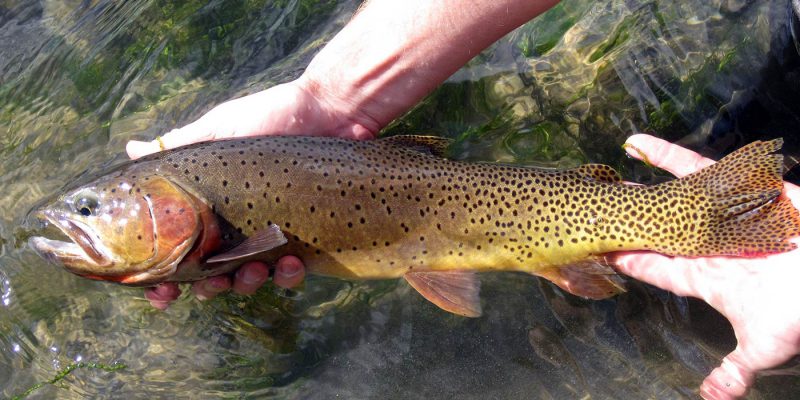
Late summer sees excellent cutthroat trout fishing with dry flies.
Late Summer Float Trips: Quick Facts
- Best Waters: The Yellowstone and Stillwater are by far the best rivers in our operations area at this time, and the two on which we do the vast majority of our guiding. The upper Missouri between Three Forks and Townsend can also be very good, though the quarry there are mostly carp rather than trout.
- Three Top Reasons to Come in Late Summer: 1.) The terrestrial dry fly fishing is great 2.) The fishing if not necessarily the catching is easier at this time than earlier in the summer, and 3.) Larger fish (on average) are more interested in dry flies than they were earlier.
- Three Top Reasons to Avoid Late Summer: 1.) During dry years, late summer is when we have fishing restrictions due to warm water temperatures and the greatest potential for forest fires, 2.) Crowds are still high, and 3.) “Match-the-hatch” fishing is limited.
- Perfect Clients: Clients who love dry fly fishing, but prefer the slightly slower pace the lower water present during this period gives to trips.
- What Late Summer Does Best: Late summer generally produces excellent dry/dropper fishing for fish that average a bit bigger than they do earlier in the summer, albeit with less consistency of weather and water conditions and therefore less consistent fishing.
Late Summer Float Trips: The Details
As the rivers drop, clear, and warm, and as aquatic insect hatches begin to decline, conditions transition into what we consider “late summer.” This is a gradual change and isn’t clear-cut. This period begins sometime in late July or early August, depending on the previous winter’s snowpack, how this snow melts, and summer weather.
The fishing during this period is similar to early summer, but it’s a little less frenetic, a little easier for beginners in terms of technique, and the fish start getting a touch spookier. While the fishing is a little harder overall than it is earlier in the summer, it remains quite good unless water temperatures get too high, and the slower pace of the fishing coupled with the better chances of big fish on dry flies make this another favorite period for many of our clients, and many visiting anglers in general.
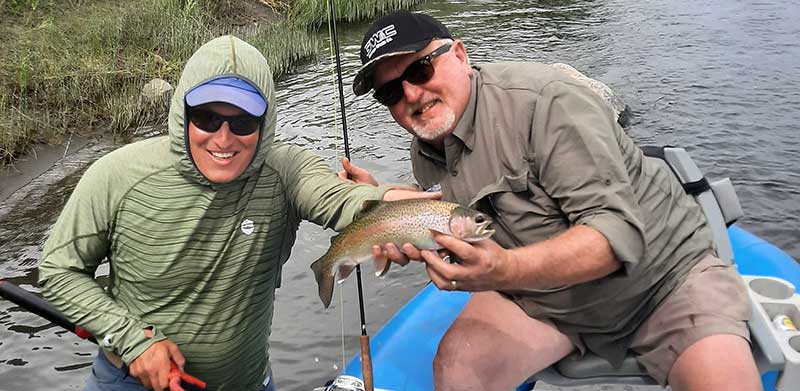
There are two key drivers to the float fishing at this time: terrestrial insects and water conditions.
The terrestrial insects, mostly meaning ants and grasshoppers, are usually the most important dry flies in late summer and are a lot of fun for most anglers to fish. The big numbers of fish usually come on ants (or occasionally small aquatic insects or nymphs), while the big trout tend to come on the larger grasshoppers.
The fish aren’t quite as eager to wallop dries at this time as they are a few weeks earlier, so anglers need to up their game a bit for success, but when anglers get it right, this is often the time that produces the most action on dries, simply because the fishing is a bit slower-paced than earlier in the summer and so it’s easier to hit more of the holding water.
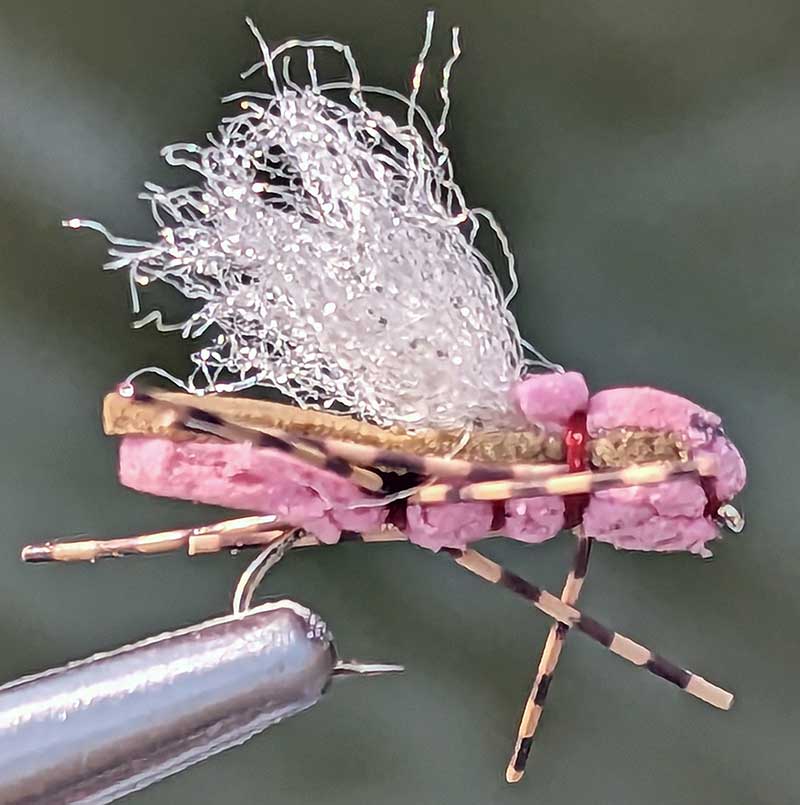
Grasshoppers often get chewed apart in late summer. Yes, pink is often THE color.
The reason the fishing has a slower pace during this period is streamflow. All rivers drop through the summer. The only question is how much they drop. If they drop too much, especially if the weather is hot and dry, they get too warm. Sometimes this means the afternoon fishing is poor. Sometimes this means that rivers are closed after 2:00PM. These are called “hoot owl” closures, and they’re getting more and more common due to global warming.
Certain rivers within our operations area are now almost always closed for part of late summer, chief among them the lower Madison and the Jefferson, but these are poor choices anyway. The real problems happen when water temperatures begin spiking over 70 degrees on the Yellowstone or Stillwater. It’s unusual for these rivers to endure hoot owl restrictions, but low water and high temperatures do lead to some tough fishing, usually in early-mid August, particularly in shallow areas of Paradise Valley and east of Livingston on the Yellowstone or after 2:00PM on the lower Stillwater.
Because of the potential for water temperature issues in mid-late afternoon, visitors looking to come in late summer must understand the risk of having to start early or cut trips short if temps are too warm. Also note that the Boulder River is never high enough for float trips during this period. This is a tiny river, so once it gets low, even a kayak would have trouble getting down it, much less a fishing raft. For similar fishing as the Boulder provides, the Stillwater River is very good unless it’s too warm.
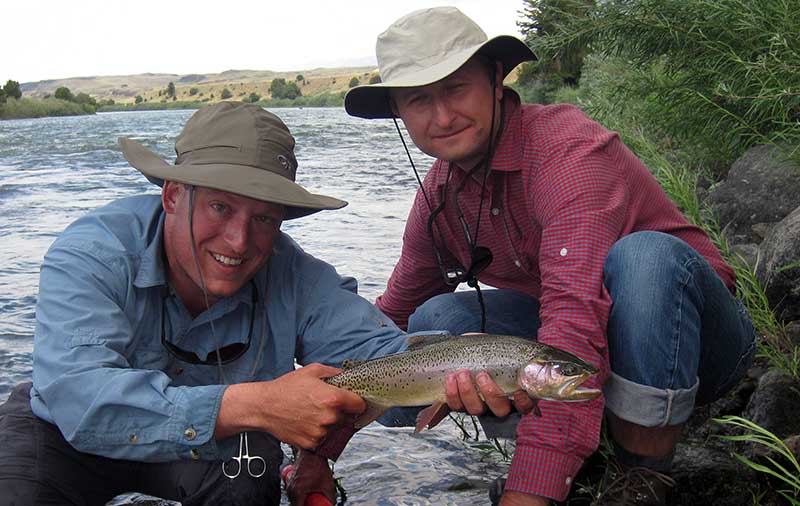
If water temperatures are okay, as they usually are on our preferred rivers (the Yellowstone and Stillwater), fishing techniques resemble those of early summer: dries, dry/dropper, and “drifting and dragging” streamers. The flies themselves change a bit, since as noted the terrestrials are the hot bugs most of the time. The fish begin moving off the banks somewhat, so we seldom “bang banks” in late summer like we do earlier. Other than these minor changes, anglers who like the sound of early summer will like late summer well, too.
Beginners will like late summer better. Since casts need not be as accurate and the currents are slower, beginners typically do better on late summer river floats than they do in early summer.
Full-day and half-day floats are available at this time. Because of the potential for water temperature problems, it’s conceivable we might need to meet for full-day trips as early as 5:00AM, though this is rare. Unlike early summer, there’s usually little point for half-day trips meeting late in the afternoon. In fact, we’ll usually run half-day trips in the mornings during this period unless we’re in the midst of a cool spell.
>>>>>>>>>>>>>>>> Return to Float Trips Page
